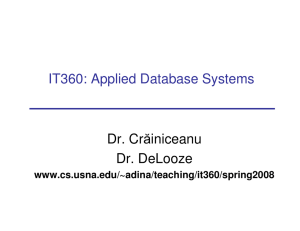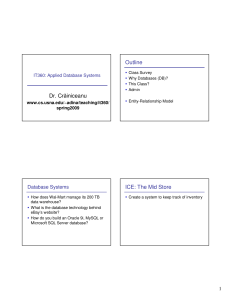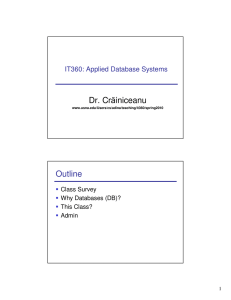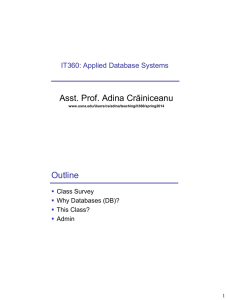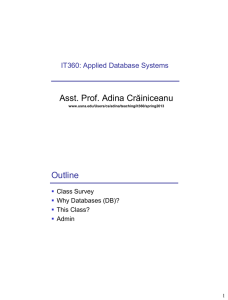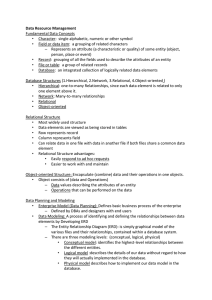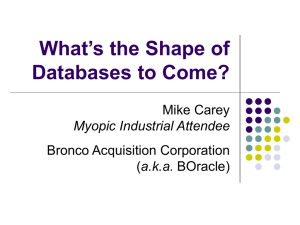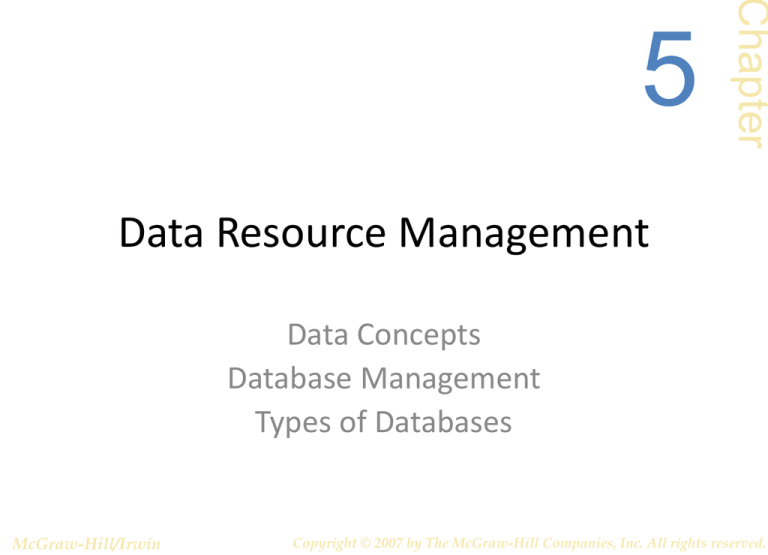
Chapter
5
Data Resource Management
Data Concepts
Database Management
Types of Databases
McGraw-Hill/Irwin
Copyright © 2007 by The McGraw-Hill Companies, Inc. All rights reserved.
Examples of logical data elements in
information systems
Fundamental Data Concepts
• Character: single alphabetic, numeric or other
symbol
• Field or data item: a grouping of related characters
– Represents an attribute (a characteristic or quality) of
some entity (object, person, place or event)
– Example: salary
• Record: grouping of all the fields used to describe
the attributes of an entity
– Example: payroll record with name, SSN and rate of pay
Fundamental Data Concepts
• File or table: a group of related records
• Database: an integrated collection of logically
related data elements
Electric Utility Database
• Figure 5.3 outlines some of the entities and relationships in a database for an
electric utility. Also shown are some of the business applications (billing, payment
processing) that depend on access to the data elements in the database.
Database Structures
• Hierarchical
• Network
• Relational
• Object-oriented
Hierarchical Structure
• Early DBMS structure
• Records arranged in tree-like structure
• Relationships are one-to-many, since each data
element is related to only one element above it.
Hierarchical Structure
Network Structure
• Used in some mainframe DBMS packages
• Many-to-many relationships
Network Structure
Relational Structure
• Most widely used structure
• Data elements are viewed as being stored in tables
• Row represents record
• Column represents field
• Can relate data in one file with data in another file
if both files share a common data element
Relational Structure
Relational Operations
• Three basic operations on relational databases:
• Select:
– Create a subset of records that meet a stated criterion
– Example, select employees who make more than $30,000
• Join
– Combine two or more tables temporarily
– Looks like one big table
• Project
– Create a subset of columns in a table
Multidimensional Structure
• Variation of relational model
• Data elements are viewed as being in cubes
Multidimensional Model
Object-oriented Structure
• Encapsulate data and their operations in one objects.
• Object consists of
– Data values describing the attributes of an entity
– Operations that can be performed on the data
• Encapsulation:
– Combine data and operations
• Inheritance:
– New objects can be created by replicated some or all of
the characteristics of parent objects
• Supports complex data types
– Examples, graphic images, video clips, web pages
Object-oriented Structure
Source: Adapted from Ivar Jacobsen, Maria Ericsson, and Ageneta Jacobsen, The Object Advantage: Business Process
Reengineering with Object Technology (New York: ACM Press, 1995), p. 65.
Copyright @ 1995, Association for Computing Machinery. By permission.
Evaluation of Database Structures
• Hierarchical
– Worked for structured routine transaction processing
– Can’t handle many-to-many relationships
• Network
– More flexible than hierarchical
– Unable to handle ad hoc requests
• Relational
– Easily respond to ad hoc requests
– Easier to work with and maintain
– Not as efficient or quick as hierarchical or network
Data Planning and Modeling
• Enterprise Model (Data Planning)
– Defines basic business process of the enterprise
– Defined by DBAs and designers with end users
• Data Modeling
– A process of identifying and defining the relationships between
data elements by Developing ERD
– The Entity Relationship Diagram (ERD) is simply graphical
model of the various files and their relationships, contained
within a database system.
– There are three modeling levels: conceptual, logical, physical
Data Planning and Modeling
Entity Relationship Diagram
Conceptual model
Conceptual model is a summarylevel data model identifies the
highest-level relationships
between the different entities.
5-22
Logical model
– Logical model is a fullyattributed data model describes
the details of our data without
regard to how they will actually
implemented in the database
– The overall logical model view
of relationships is called schema.
– The logical model view to
support specific application
programs is called subschema.
5-23
Physical model
- Physical model is a fullyattributed data model
describes how to implement
our data model in the
database
- Or How data are to be stored
and accessed on storage devices
5-24
Traditional File Processing
• Data stored in independent files
• Problems:
– Data redundancy: duplicated data in several files,
caused problems when data had to be updated.
– Lack of Data Integration: it difficult to provide end
users with information for ad hoc requests that
required accessing data stored in several different
files.
Section II: Database Management
Approach
• Consolidate data into databases that can be accessed by
different programs
• the main software tool of the database management
approach is a database management system (DBMS).
• DBMS serves as interface between users and databases.
This helps users easily access the data in a database.
• Example on DBMS that allow you to set up and manage
databases on microcomputers : Microsoft Access, Lotus
Approach, or Corel Paradox
• Examples of popular mainframe and server versions of
DBMS software are Oracle 10g by Oracle Corp., MySQL, a
popular open-source DBMS, and IBM’s DB2 Universal
Database, .
DBMS
DBMS Major Functions
• The three major functions of a database
management system are
– Database Interrogation.
– Database Maintainence.
– Database Development and Database application
development.
Database Interrogation
– Database Interrogation:to access the data in a
database to selectively retrieve and display
information and produce reports, forms, and other
documents.
• is the primary use of a database by end users
Database Interrogation
• End users use a DBMS by asking for information via a
query or a report generator
• Query language – immediate responses to ad hoc data
requests
– SQL (Structured Query Language) an international standard
query language.
• SQL language is a combination of DDL, DML and the SELECT
statement
– Graphical Queries -- Point-and-click methods
– Natural Queries – similar to conversational English
• Graphical and Natural Queries are translated by the software into SQL
commands.
• Report generator – quickly specify a report format for
information you want to present as a report
Natural Language versus SQL
Graphical Query
Source: Courtesy of Microsoft Corp.
Database Maintenance
• Database maintenance involves using
transaction processing systems with support of
DBMS to add, delete, update, and correct the
data in a database.
• Updating database to reflect new business
transactions such as a new sale.
Database Development
• Database development: involves defining and organizing the
content, relationships, and structure of the data needed to build
a database.
• Metadata: data definitions and specifications of the data contents,
relationships and structure
– The metada are stored in data dictionary and maintained by DBA
– Data dictionary: Data base catalog containing metadata
• Data Definition Language (DDL):
– Develop and specify the data contents, relationships and structure
and modify the database specifications when necessary
• Database Administrator (DBA)
– In charge of database development and maintaining the metadata
using the DDL
Database application Development
• Database application development involves using a DBMS
software development tools to develop prototypes of
queries, data entry screens, forms, reports, and Web pages
for a proposed custom business application that accesses a
company database to find and update the data it needs.
• DBMS can include features such as data manipulation
language (DML) to perform necessary data-handling
activities.
• Data Manipulation Language (DML): modify stored data but
not the schema or database objects.
• Manipulation of persistent database objects, e.g., tables or
stored procedures, via the SQL schema statements, rather
than the data stored within them, is considered to be part of
a separate data definition language(DDL)

